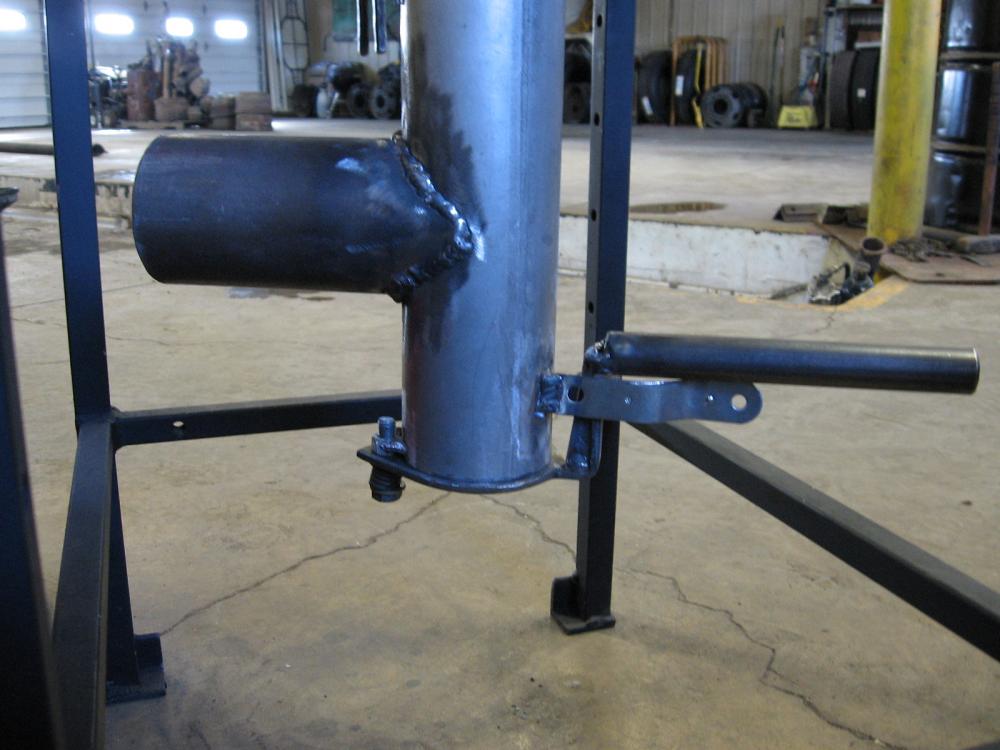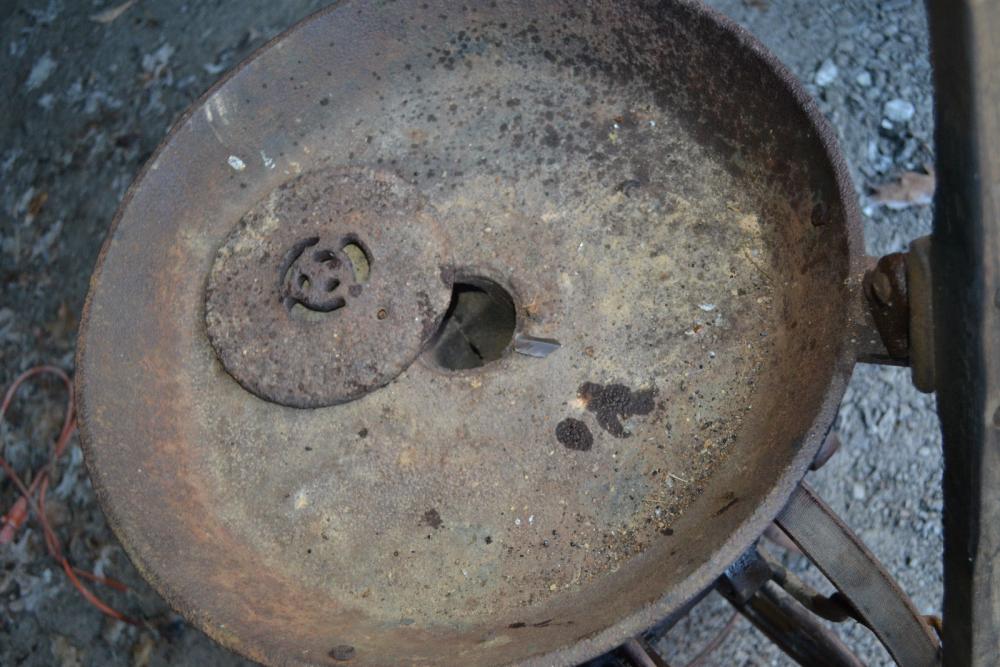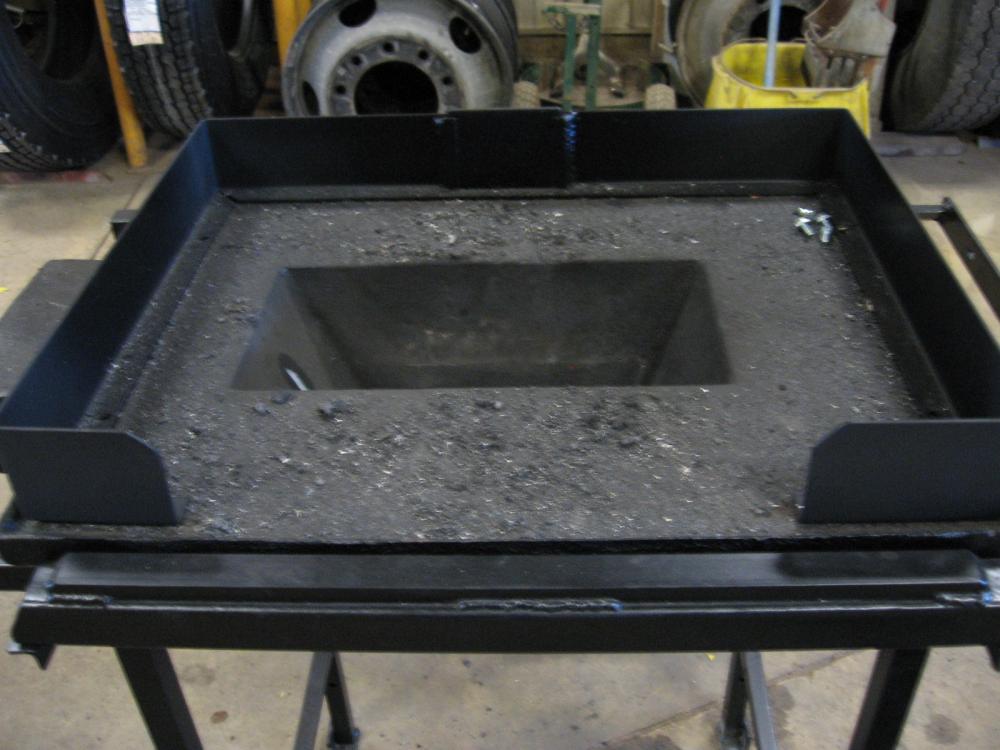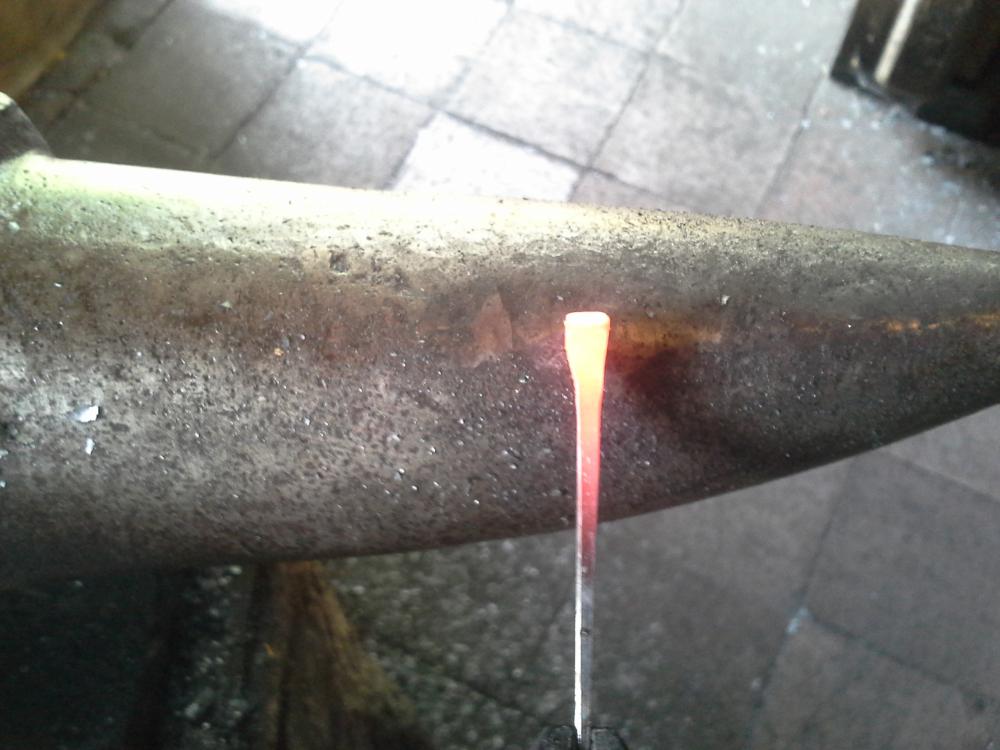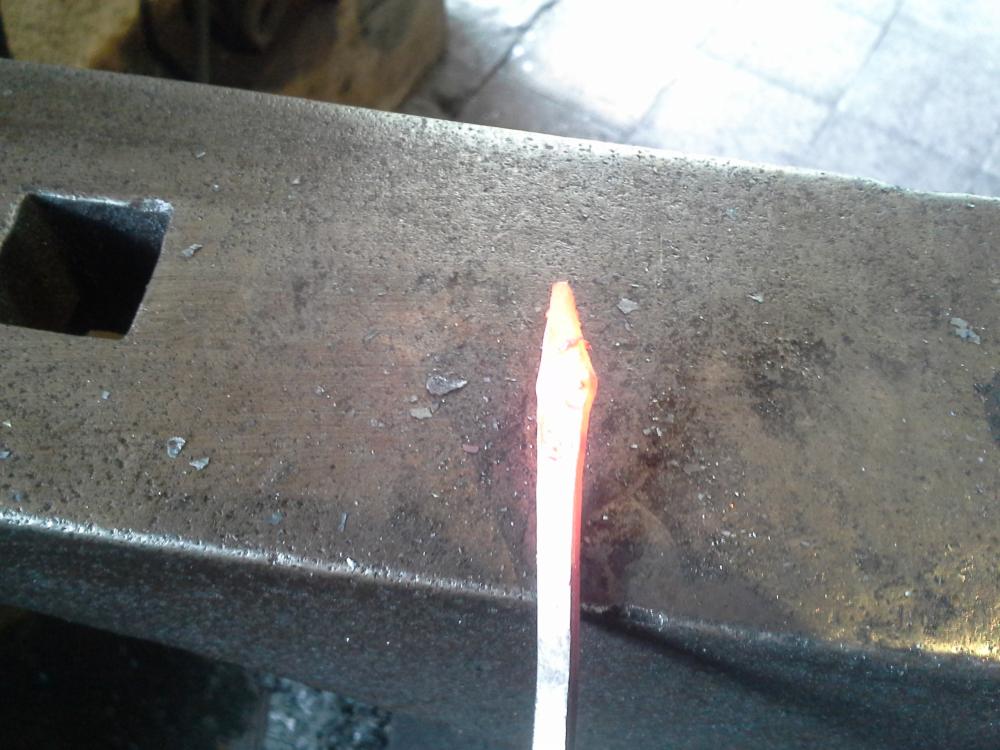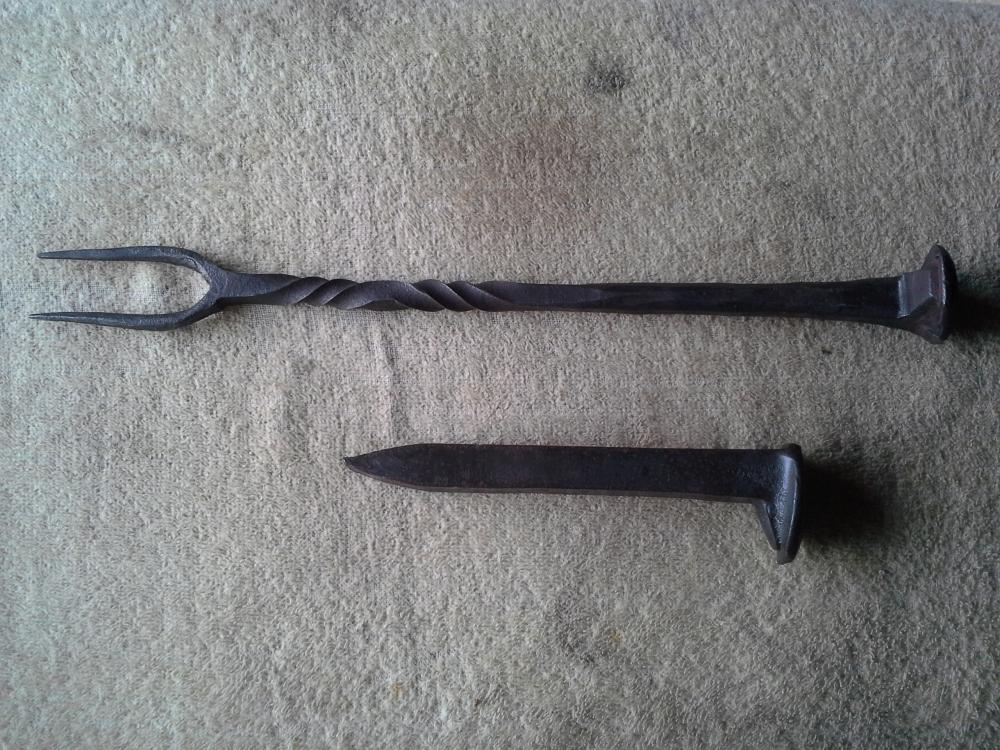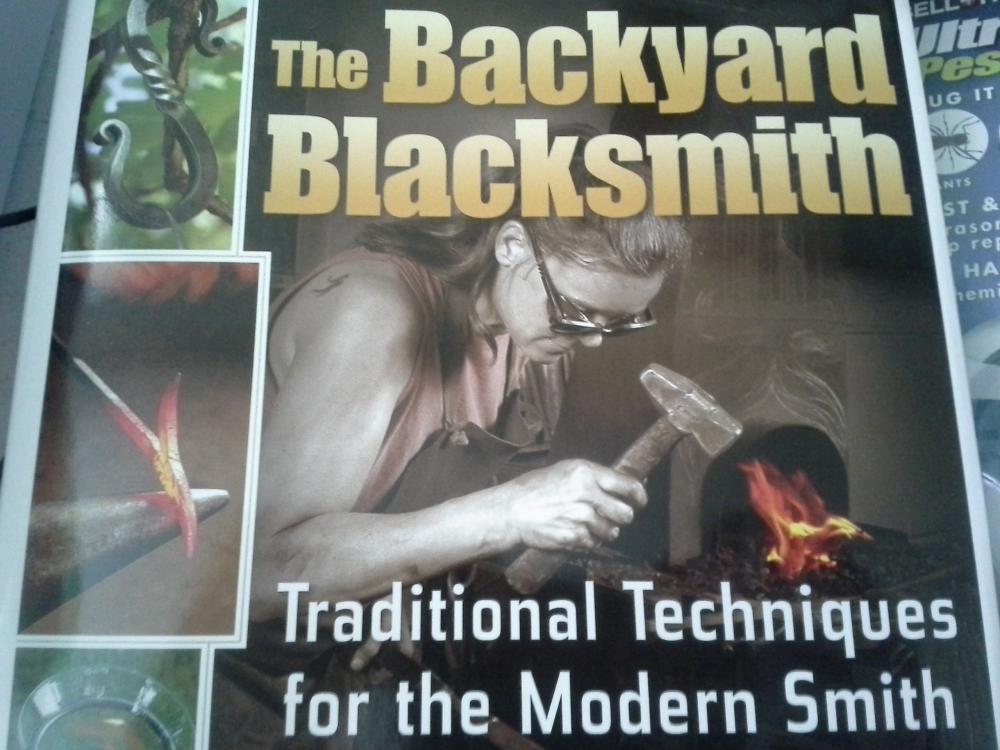-
Posts
1,227 -
Joined
-
Last visited
Content Type
Profiles
Forums
Articles
Gallery
Downloads
Events
Everything posted by SReynolds
-
He uses that method for tongs???? OK, but when making tongs doesn't everyone make the rivet in the tongs? I mean, you don't make a rivet before hand. You just score a section of the proper sized round stock (to the length you'd need per the tongs) heat the tongs and round stock at same time, place the round stock into the two holes, break it free from the parent material and head the exposed end of stock while at heat. The bottom half of said tong is held over (onto) a bolster plate, so the bottom of the rivet isn't upset yet. Do that after you upset the first end. I guess that is another method to manufacture a rivet, but you's have to have stock to place the round stock and (soon to become) rivet into.
-
"T" You need a fire pot with access to it to place your stock into the fire ball. But how have you been heating your stock (which you are saying is difficult or cannot do) if you are familiar with how to make knives?
-
Good on you. Happy Anniversary !!!
-
I have mentioned that a number of times to folks visiting the shop, my students and here on the forum. You can't forge with coal. It seems to form coke. I see the jokes haven"t gotten any better here on the site. Though I did enjoy the SAR dog reference.
- 13 replies
-
- blacksmith
- coal
-
(and 1 more)
Tagged with:
-
What he said. Many students attend my class have tried to make a forge of sorts and (obviously) hammer out knives from RR Spikes. cuz that is what we all want to start with........... LOL When they obtain hands-on experience their eyes are opened and they advance their knowledge of the craft. I invite some of them back to "work" with me in the shop as an "apprentice" for a day. Sorta a one-on-one session to build confidence. They can't believe how difficult it is to simply draw-out a 3/8" round rod to a three inch long taper and then round that. A beginners hammer control exercise most don't desire to learn. A brake drum forge will destroy a 5/8" square RR Spike in short order if the air supply is adequate, such as a hair dryer set to low speed with excess air dumped to atmosphere via a gate valve. On low speed, a simple hair dryer will just about lift a bed of coke out of the forge.
-
I have been enjoying demos on you tube of many different methods of riveting. I have manufactured a number of different tools to assist. I have found that the hub-bub of rivet making has become so overly complex I contemplated how to make them in the most simplest form. I have come to the conclusion that drawing them like a nail from larger stock (obviously round and no taper/point) is so simple I have to wonder if anyone else does this. I employ the shouldering method of nail production. If you don't know shouldering method, you may be lost on this topic. A simple header just like a nail header (obviously round hole, not square) is employed to head said rivet. The head can be made to any shape or leave it flat. If the rivet must be longer than what you want to draw-out then you are out of luck, but honestly I don't make too many rivets longer than an inch or three. I have to upset the stock to make real long rivets, but they are more of a "pin" not a rivet.
-
ever notice when you buy a real big used hammer, that there be evidence it was once employed as an "anvil"? speaking of anvils, I hope to see a variety while there. The local Farrier supply has quite a collection, but only one double horn. You just don't see them about. Everything is London with a farrier mod like clip horn or double pritchel hole.
-
thus heating it to sparkling white and spitting sparks would be normal heating for wrought? That would not be overheating it?
-
I won't buy any. There are some sections of fence and assorted "scrap" in the shop I work at. They buy all I need and obviously select CF 1018 or HR due to price and what I make. Sorta enjoy experimenting with spring steel and this wrought. But my past is filled with low carbon steel and it works well for me. I will try overheating it . Good idea. Get a feel for what it looks like and characteristics.
-
I will eexperiment further. Didn't have alot of time then. I guess it moved easily........I was swinging five pounds so I cannot rightly say. May be my usual 2.5 pound hammer will be a better judge. Don't have too much 3/4" I work with. I may have some truck spring U-bolts I can try. And forge welding will be an interesting experience as well. How would one go about making it sparkling hot? It's wrought. Will it act similar to mild steel/1018 and throw sparks at white heat?
-
Found some lengths of 3/4" rounds wrought. I had read how popular it is and how folks clamor over it. Especially how it has to be worked hot. So in heating I make it yellow. Ok so far? Then I work it and very soon it delaminates. So in trying it again and again; over and over, it delaminates. At what color should I stop working it? I don't intend to make anything. I would like to learn the secret of this as to why folks want it. I figure I get about 10 seconds to work 3/4" round. Much after ,it literally falls apart. It moves ok but I have no time to work it. Sound about right ? If so , I have to wonder why there were not more blacksmith shops suicides "in the day"
-
yes!!! I hadn't thought of that! Actually...I hadn't thought of this. I have students make a quarter sized circle from the nail head. Then scroll an eye and then hook. Cold punch a hole near the top of said circle. Very very very careful hammer control to forge a circle. Obviously, students cannot do that, but I demonstrate hammer control so they realize that they are not ready to jump into swords. Which is what THEY ALL WANT TO MAKE AND NOTHING ELSE. So I have then forge a very simple flame finial from 1/4" square stock. One students said, "can you forge a flame from a horseshoe nail head"? I dunno......... The flame tip can have a wave to it or not. I do both. One can make the draw-out more pronounced to incorporate a very long flame tip, but it begins to look hoky if they are any longer than what I have.
-

blacksmithing do's and don't's
SReynolds replied to Mark Ling's topic in Blacksmithing, General Discussion
Don't.......... wear gloves and enjoy the freedom of handling hot iron. Cuz when you go to pick up that hot object just like you normally do it be too late to come to realization that you hadn't slipped on your bulky leather glove(s) Do......... get the word out that a blacksmith shop is not a steel mill with blast furnace, billowing black coal smoke and heavy machinery pounding away casting a shadow against the walls from 40 foot tall flames in the furnace. -
I can swing 6 lbs 9 oz effectively per the digital scale. But only when I have to. I hope the guys are busy making merry and not trying to impress the crowd by moving 3/8" stock with 8 pound hammers.
-
I'd like to pay close attention to the hammers guys are using. I can only imagine it is a "I swing a bigger hammer than you" competition as per talk with local/simple folk who focus not on what one forges but rather the size of hammer. always the hammer.
-
Make em wide or long and narrow. I forge the flame tip first on horn. Then lay the meaty portion of nail head on near side edge of face. Hammer just off center to widen. Little bit to left and same to right. The hook; I roll an eye to back side with scrolling tong and then the hook to the front with same or a jig. I place a punched hole in the flame. I perform that cold and with help from a punching block. I can hand these out to folks if I like when they visit the historic village smithy or sell them. Make great key ring hangers. I can make one while folks watch even if the have a very short attention span. No. 16 horse shoe nail. These are of my own invention. Feel free to use them as you like.
-
I do plan to be there THIS YEAR! . Never have I in the past. I'm busy building things,,,,smithing etc. Shame on me. Who is going to set-up shop there/display or a tent to sell items. I'd like to look up folk when there. I will attend Friday the 23rd. as of this time. Looks like three hour drive from what I recall as I often visit the Write Pat AF Museum in Dayton.
-
Hummm........camping this weekend.......after a Saturday in the village smithy of course.
-
I do like the idea of bacon myself , to coat a forged utensil. An eat some too while I'm at it. But now, my cat is after my utensils. . . . .
-
Too many oils to choose from ! Mono. Non mono. Saturated. Non sat. Veggie. Mutton fat..... I'm just gonna slap on some led-based paint and be done.
-
I dunno. I have always coated the hot dog forks I make with a rag somewhat soaked with oil. I do it when the piece is hot to touch. I sand off the black oxide a little with emry where the dogs set. I think the grease in the dogs and the brats coat the steel When used. I figure folks is wise enough to wash the pointed end prior to use. I do anyways. Some opinions may vary. I will try wiping them down when warm with olive oil.
-
I have olive oil. Extra virgin.
-
Ummm.....engine oil.
-
some free time at forge today. what to do. . . . .One of my students drew out a RR spike. Which inspired me to do same and add some embellishments to mine. I don't have a grill but know some who do.
-
I get it. Thanks. Lost in translation. How about this; a popular smithing book ( not going to mention names) advised NOT to use a worn anvil. Sway is not good. Chipped corners are best repaired by welding and grinding. Keep this in mind, please when folk ask. How to books are telling folk how to. If you read it in a book It must be legit. Remember my comment about a book instructing you must scarf all welds or it is improper (I belive the text said subject to fail) My favorite suggestion is applying bees wax at a red heat.

